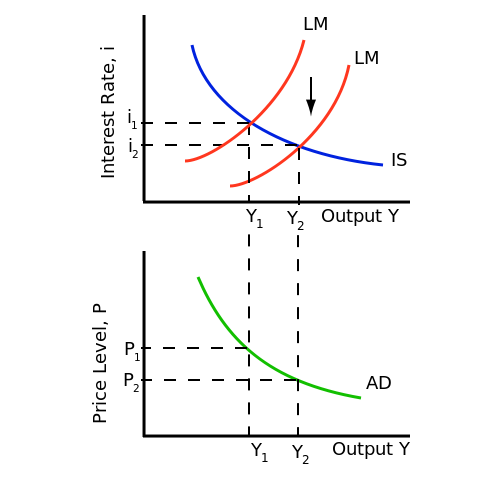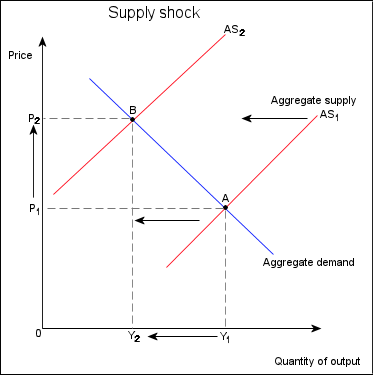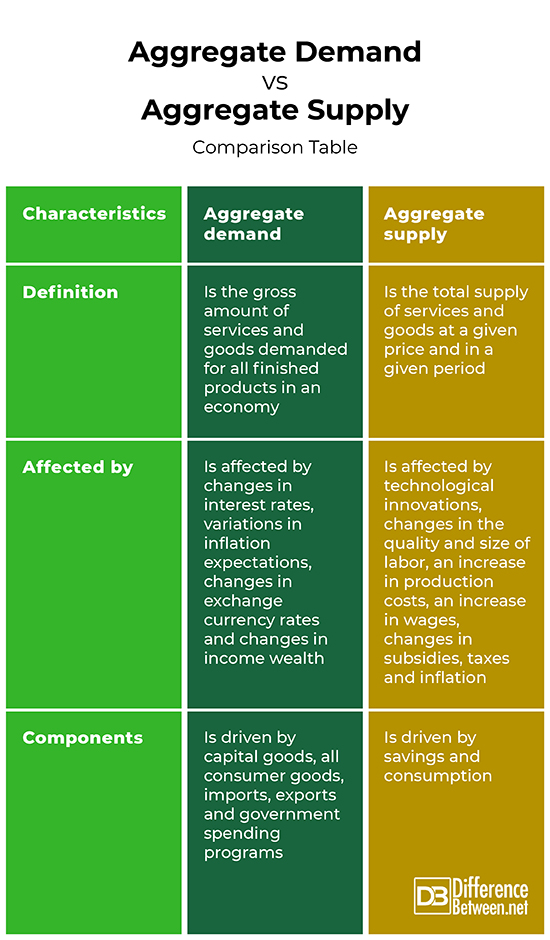Difference Between Aggregate Demand and Aggregate Supply
Whether you are an economist or not, you have probably come across the law of supply and demand whereby an increase in price leads to a decrease in demand and a decrease in price leads to an increase in demand, assuming that other factors remain constant. Supply and demand show the direct relationship between what consumers demand and what is supplied in an economy. As such, any imbalance between the two affects the price of commodities in the market. Although aggregate demand and aggregate supply determine equilibrium when graphed together, they have differences.

What is Aggregate demand?
This is the gross amount of services and goods demanded for all finished products in an economy.
In the long term, this aggregate demand equals the gross domestic product in the market. Although GDP and aggregate demand increase and decrease at the same time, aggregate demand only falls at par with the GDP in the long run after adjusting of the price level. However, other variations can also occur based on the components and methods used.
Aggregate demand is made up of capital goods, consumer goods, imports, exports and government spending. Among factors that can affect aggregate demand include changes in interest rates, variations in inflation expectations, changes in exchange currency rates and variances in income wealth.
Aggregate demand can be derived by summing consumer spending, corporate spending and private investments, government spending and net exports.

What is Aggregate supply?
Also referred to as total output, this is the total supply of services and goods at a given price and in a given period.
When supply is constant amid an increase in demand, consumers pay higher prices for goods. This forces firms to increase output resulting in an increase of supply, which then normalizes the prices and output.
Changes in aggregate supply can be caused by technological innovations, changes in the quality and size of labor, an increase in production costs, an increase in wages, changes in subsidies, taxes and inflation.
In aggregate supply, an increase in demand leads to an increase in the use of current inputs in the production process in the short run. However, aggregate supply is not affected by price levels in the long run. It is only driven by efficiency and improvements in productivity.
Similarities between Aggregate demand and Aggregate supply
- Both are used in the context of economic theories
- When graphed together, the two determine the equilibrium
Differences between Aggregate demand and Aggregate supply
Definition
Aggregate demand is the gross amount of services and goods demanded for all finished products in an economy. On the other hand, aggregate supply is the total supply of services and goods at a given price and in a given period.
Affected by
Aggregate demand is affected by variances in interest rates, variations in inflation expectations, changes in exchange currency rates and changes in income wealth. On the other hand, aggregate supply is affected by technological innovations, changes in the quality and size of labor, an increase in production costs, an increase in wages, changes in subsidies, taxes and inflation.
Components
Aggregate demand is driven by capital goods, all consumer goods, imports, exports and government spending programs. On the other hand, aggregate supply is driven by savings and consumption.
Aggregate demand vs. Aggregate supply: Comparison Table

Summary of Aggregate demand vs. Aggregate supply
Aggregate demand is the gross amount of services and goods demanded for all finished products in an economy. It is driven by capital goods, all consumer goods, imports, exports and government spending programs. On the other hand, aggregate supply is the total supply of services and goods at a given price and in a given period and is driven by savings and consumption and is driven by savings and consumption.
- Difference Between Profit Center and Investment Center - July 2, 2022
- Difference Between Anti-Trust and Anti-Competition - June 6, 2022
- Difference Between Stocktaking and Stock Control - June 6, 2022
Search DifferenceBetween.net :
Leave a Response
References :
[0]Image credit: https://commons.wikimedia.org/wiki/File:Economics_supply_shock.png
[1]Image credit: https://upload.wikimedia.org/wikipedia/commons/thumb/2/29/IS_LM_Aggregate_Demand_Relation.svg/500px-IS_LM_Aggregate_Demand_Relation.svg.png
[2]Goodman R & Morton J. Advanced Placement Economics: Teacher Resource Manual. Council for Economic Educat, 2005.https://books.google.co.ke/books?id=SYe93WTv4-YC&pg=PA328&dq=Difference+between+Aggregate+demand+and+Aggregate+supply&hl=en&sa=X&ved=2ahUKEwjQ-cqayuTsAhUUnVwKHashBkkQ6AEwAHoECAQQAg#v=onepage&q=Difference%20between%20Aggregate%20demand%20and%20Aggregate%20supply&f=false
[3]SBPD Editorial Board. Economics Model Paper. SBPD Publications, 2016. https://books.google.co.ke/books?id=ECqWDQAAQBAJ&pg=PA76&dq=Difference+between+Aggregate+demand+and+Aggregate+supply&hl=en&sa=X&ved=2ahUKEwjQ-cqayuTsAhUUnVwKHashBkkQ6AEwA3oECAEQAg#v=onepage&q=Difference%20between%20Aggregate%20demand%20and%20Aggregate%20supply&f=false
[4]Roger A. Arnold. Macroeconomics. Cengage Learning, 2008. https://books.google.co.ke/books?id=fmsP-fTAaCUC&pg=PA181&dq=Difference+between+Aggregate+demand+and+Aggregate+supply&hl=en&sa=X&ved=2ahUKEwjQ-cqayuTsAhUUnVwKHashBkkQ6AEwBnoECAcQAg#v=onepage&q=Difference%20between%20Aggregate%20demand%20and%20Aggregate%20supply&f=false
